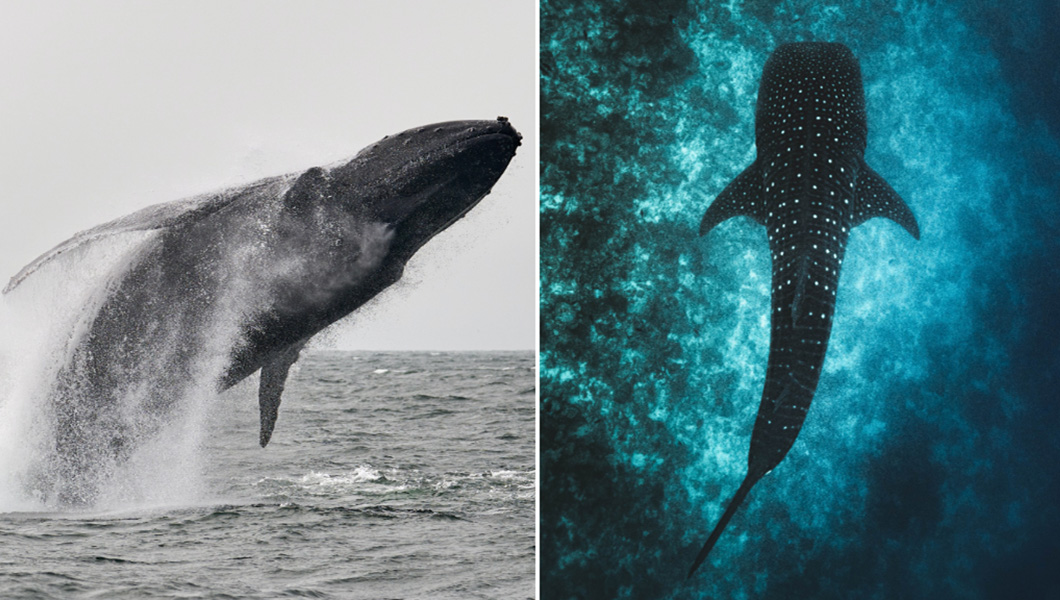Sea giants explained: discover the largest creatures of the ocean

Blue is the colour that guarantees our survival.
Earth would not be Earth without water, with its majestic oceans and the varied marine fauna that populate our gorgeous blue planet.
Magnificent oceans, flowing rivers, rain and snow falling from the sky: water is a treasure we enjoy (and sometimes abuse) every day, and Guinness World Records 2024 is largely dedicated to its celebration.
Have you ever wondered what are the secrets that lurk beneath the ocean’s surface? For example, what is the world’s largest fish?
Where is most of the freshwater on our planet stored (spoiler: most of it is either trapped in glaciers or under the surface of the earth)? What is the largest octopus EVER and why does it have nine brains?
Today, we take the plunge into the watery element of our world and turn the spotlight on two of the record-breaking creatures that inhabit our oceans.

With its whopping size and recognizable features, the largest fish inhabiting our oceans is the endangered whale shark (Rhincodon typus).
Despite its daunting name, like many other mega-sized animals, this specimen is known to be a deep-diving, shy, slow swimmer that enjoys privacy and peace.
Whale sharks are often referred to as ‘gentle giants’ and can be found in the warmer areas of the Atlantic, Pacific and Indian oceans.
Even if only a small part of the whale shark population grows into adulthood (a mere 10% is estimated to survive past the very first stage of their life cycle) and reaches sexual maturity at 30 years old, the ones who survive can grow incredibly old.
Although the average lifespan of this oversized shark reaches 70 years, a few lucky individuals can live as long as 150 years!
These elusive beasts can migrate for long distances, and their size can vary drastically depending on their region, age and sex.
Unsurprisingly, to reach such dimensions they need plenty of food.
Their diet is varied and composed of tiny shrimp, fish and plankton, which they ingest through filtering water: these majestic beasts are filter eaters, meaning that they can’t bite.
However, they are equipped with over 3,000 tiny teeth, each less than 2.5 centimetres (1 inch) long, which they use to ingest, filter and process over 6,000 litres of water per hour.
Incredibly, they also have teeth on the surface of their eyes!
These tiny teeth-like scales (also called dermal denticles) have been theorised to protect the eye since the whale shark doesn’t have eyelids.

The individuals measured to date have averaged 4–12 metres (13 feet–39 feet) long.
The largest scientifically documented whale shark was a female, caught in the Arabian Sea off Veraval in Gujarat, India, on 8 May 2001; she measured a whopping total of 18.8 metres (61 feet 8 inches).
Although a regular whale shark is impressive in size, it’s not the overall largest animal that roams the sea.

The title of largest mammal on Earth, and largest animal overall that EVER existed, dinosaurs included, goes to the blue whale (Balaenoptera musculus).
The average specimen of blue whale measures around 20–30 metres (65–100 feet) and weighs c. 160 tonnes (roughly 320,000 lbs), and it can reach a maximum confirmed length of 33.57 metres (110 feet 1 inch).
Sadly, such 33.57-m blue whale was never weighed.
“The blue whale can grow up to 30 m (98 ft) long – around the same as a Boeing 737,” writes Robert Dimery explaining the anatomy of the gigantic animal.
The heaviest blue whale overall (which is also the heaviest animal ever weighed) was a female specimen that tipped the scales at 190 tonnes (418,878 lb). It measured a jaw-dropping total of 27.6 metres (90 feet 6 inches) in length.
Incredibly, such a mammoth animal feeds primarily on krill.
Eating up to six tons of krill per day, blue whales eat by ingesting and filtering huge volumes of salty water: they subsequently push the water out, and the food is trapped through their keratin-made baleen plates.

Thirsty for more?
Don’t worry, you don’t have to plunge into the deep sea to learn the secrets of these gigantic creatures.
Find more record-breaking, jaw-dropping marine mega-animals in Guinness World Records 2024, out now in libraries and online!
But the blue whale is, understandably, also the record holder for a wide range of other records.
Among many other impressive features, they have the heaviest tongue (measuring 4 tonnes (8,818 lb), almost like an adult elephant!).
With a capacity of 5,000 litres (1,320 US gal), they can also boast the largest lungs.
Blue whales also have the slowest heart rate and largest heart ever measured of any living creature.
Although it beats only eight times a minute, it measures around 680 kg (1,500 lb), which is the same size as a VW Beetle car. Not bad or an animal that weighs about 20 times a fully grown T-rex!

Want more? Follow us on Google News and across our social media channels to stay up-to-date with all things Guinness World Records! You can find us on Facebook, Twitter/X, Instagram, Threads, TikTok, LinkedIn, and Snapchat Discover.
Don't forget to check out our videos on YouTube and become part of our group chat by following the Guinness World Records WhatsApp channel.
Still not had enough? Click here to buy our latest book, filled to the brim with stories about our amazing record breakers.


